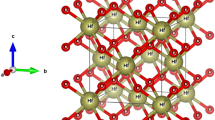Abstract.
To describe metal surfaces efficiently and accurately, an embedding atom-jellium model is proposed. Within density functional theory, we consider a multiscale scheme that combines jellium and atomistic approaches. We use the former to model layers deep inside a metal surface to reduce the computational cost and the later to maintain the accuracy required for chemical bonding. Work functions of Al(111) and Cu(111) surfaces are studied using this model with comparisons to all-atom and pure jellium models. The much closer results of the embedding atom-jellium model to the all-atom results than to the pure jellium results show a good prospect for our approach in large-scale density functional calculations.
Similar content being viewed by others
References
J. Bardeen, Phys. Rev. 49, 653 (1936)
N.D. Lang, Solid State Commun. 7, 1047 (1969)
N.D. Lang, W. Kohn, Phys. Rev. B 3, 1215 (1971)
P. Hohenberg, W. Kohn, Phys. Rev. B 136, B864 (1964)
W. Kohn, L.J. Sham, Phys. Rev. 140, 1133 (1965)
M.C. Payne, M.P. Teter, D.C. Allan, T.A. Arias, J.D. Joannopoulos, Rev. Mod. Phys. 64, 1045 (1992)
W.L. Yang, V. Brouet, X.J. Zhou, H.J. Choi, S.G. Louie, M.L. Cohen, S.A. Kellar, P.V. Bogdanov, A. Lanzara, A. Goldoni, F. Parmigiani, Z. Hussain, Z.X. Shen, Science 300, 303 (2003)
L.-L. Wang, H.-P. Cheng, Phys. Rev. B 69, 045404 (2004)
O. Gunnarsson, B.I. Lundqvist, H. Hjelmberg, Phys. Rev. Lett. 37, 292 (1976)
D.L. Price, J.W. Halley, Phys. Rev. B 38, 9357 (1988)
E. Ogando, N. Zabala, E.V. Chulkov, M.J. Puska, Phys. Rev. B 71, (2005)
G. Makov, M.C. Payne, Phys. Rev. B 51, 4014 (1995)
J. Ihm, A. Zunger, M.L. Cohen, J. Phys. C-Solid State Phys. 12, 4409 (1979)
M. Bockstedte, A. Kley, J. Neugebauer, M. Scheffler, Comp. Phys. Commun. 107, 187 (1997)
G. Kresse, J. Furthmüller, Comput. Mat. Sci. 6, 15 (1996)
G. Kresse, J. Furthmüller, Phys. Rev. B 54, 11169 (1996)
D. Vanderbilt, Phys. Rev. B 41, 7892 (1990)
H.J. Monkhorst, J.D. Pack, Phys. Rev. B 13, 5188 (1976)
F.K. Schulte, Surf. Sci. 55, 427 (1976)
N.W. Ashcroft, D.C. Langreth, Phys. Rev. 155, 682 (1967)
R. Monnier, J.P. Perdew, Phys. Rev. B 17, 2595 (1978)
A. Kiejna, Phys. Rev. B 43, 14695 (1991)
Author information
Authors and Affiliations
Corresponding author
Rights and permissions
About this article
Cite this article
Wang, LL., Cheng, HP. Embedding atom-jellium model for metal surface. Eur. Phys. J. D 43, 247–250 (2007). https://doi.org/10.1140/epjd/e2007-00115-8
Received:
Published:
Issue Date:
DOI: https://doi.org/10.1140/epjd/e2007-00115-8




